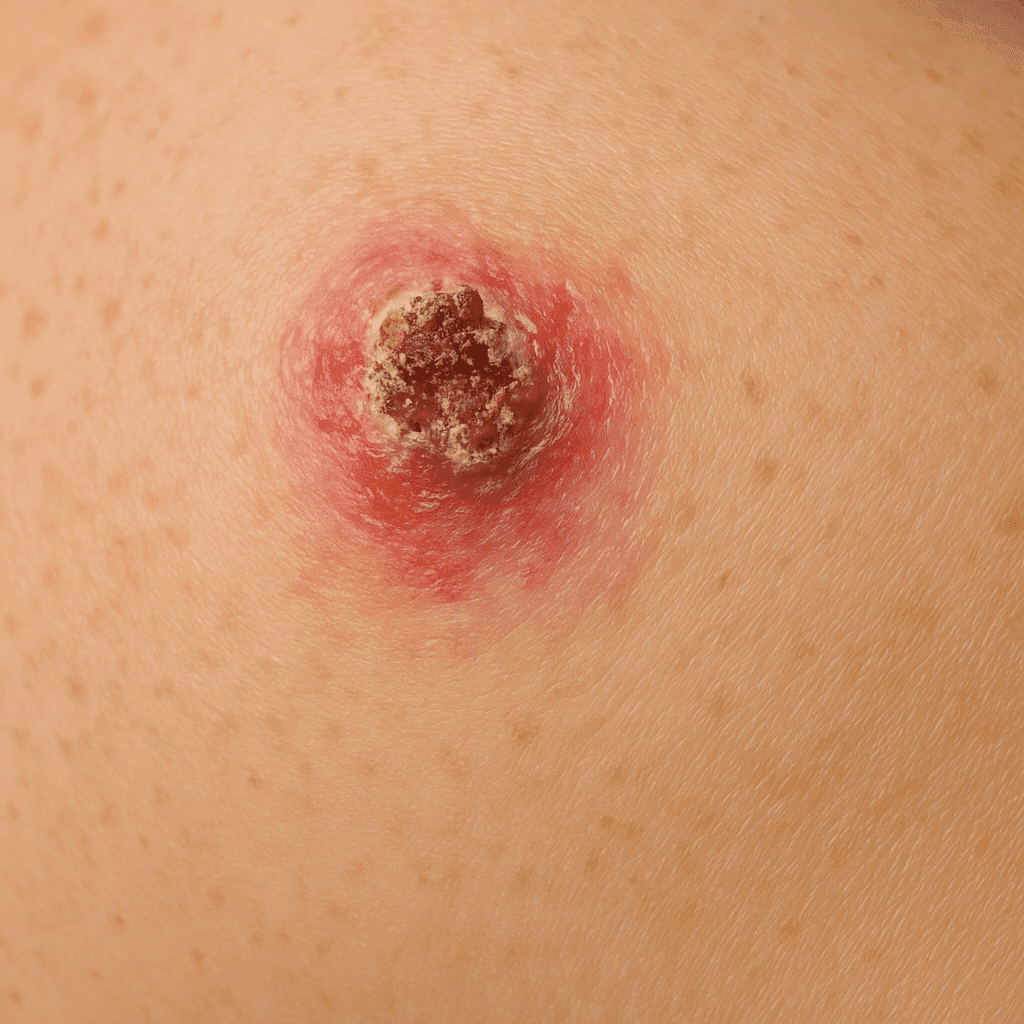Squamous cell carcinoma of the skin
Introduction
Squamous Cell Carcinoma (SCC) is one of the most common skin cancers, along with basal cell carcinoma. Its development occurs from the squamous epithelial cells that make up the surface of the skin. Although SCC is less dangerous than melanoma, its early diagnosis and treatment are crucial to avoid complications and metastasis.
The importance of early diagnosis of squamous cell carcinoma cannot be overstated. Early stage of the disease allows for effective treatment that minimizes the risk of spreading the cancer to other parts of the body. Regular dermatological examinations and self-observation of the skin can significantly increase the chances of early detection of a cancerous lesion.
Symptoms of squamous cell carcinoma of the skin
Early symptoms
In its early stages, squamous cell carcinoma can resemble harmless skin lesions such as warts, psoriasis or eczema. Early symptoms include:
- Rough, scaly patches on the skin
- Red, sometimes itchy nodules
- Small, hard nodules that may enlarge over time
Advanced symptoms
As the disease progresses, symptoms can become more pronounced and worrisome:
- Nodules that turn red or brown in color
- Sores that do not heal
- Pain or bleeding from the affected areas
Recognizing these symptoms early is key to effective treatment and avoiding complications.
Risk factors
Exposure to UV radiation
One of the main risk factors for developing squamous cell carcinoma of the skin is prolonged exposure to ultraviolet (UV) radiation from the sun or tanning beds. People who work outdoors and tanning enthusiasts are particularly vulnerable to this type of cancer.
Genetic predisposition
Genetic factors also play an important role in the risk of developing SCC. People with a family history of skin cancer should be especially vigilant and examine their skin regularly.
Other environmental factors
In addition to UV radiation, other environmental factors can increase the risk of SCC, such as exposure to industrial chemicals or long-term use of immunosuppressive drugs.
Diagnostics
Clinical examination
The diagnosis of squamous cell carcinoma of the skin begins with a thorough clinical examination by a dermatologist. The doctor evaluates the skin lesions for their appearance, size and any associated symptoms.
Skin biopsy
The most important diagnostic step is a skin biopsy, which involves taking a tissue sample from the suspected lesion. Histopathological examination of this sample allows confirmation of the presence of cancer cells.
Other diagnostic methods
In some cases, especially when metastasis is suspected, additional tests such as a CT scan or MRI may be needed.
Treatment of squamous cell carcinoma
Surgery
Surgery is the most common treatment for SCC. It involves surgical removal of the cancerous lesion along with a margin of healthy tissue to prevent recurrence.
Radiation therapy
Radiation therapy is an alternative or adjunct to surgery, especially in cases where surgical removal of the lesion is difficult due to its location.
Drug therapies
In cases of advanced SCC, drug therapies, such as drugs targeting specific genetic mutations of the tumor, may be used.
Modern treatment methods
In recent years, modern treatment methods have been developed, such as photodynamic therapy, which uses light to activate drugs that destroy cancer cells. Immunotherapy is also gaining ground, boosting the immune system's response to cancer cells.
Prognosis and complications
Factors affecting prognosis
The prognosis of squamous cell carcinoma depends on a number of factors, including the stage of the disease at the time of diagnosis, the location of the lesion and the patient's overall health.
Possible complications after treatment
Treatment of SCC may be associated with complications, such as surgical scarring, changes in skin pigmentation and, in the case of radiation therapy, damage to adjacent tissues. Early detection and treatment of the cancer can minimize these risks.
Prevention
Protection from UV radiation
The most important element in the prevention of squamous cell carcinoma is to protect the skin from UV radiation. It is advisable to use high SPF sunscreens, wear protective clothing and avoid the sun during its peak hours.
Regular dermatological examinations
Regular visits to the dermatologist and self-observation of the skin allow early detection of cancerous changes. People at high risk should take special care to have such examinations regularly.
Healthy lifestyle
A healthy lifestyle, including a balanced diet, regular physical activity and avoidance of stimulants, supports the body's overall immunity and can help reduce the risk of developing skin cancer.
Differences between squamous cell carcinoma and other skin cancers
Comparison with basal cell carcinoma
Squamous cell carcinoma differs from basal cell carcinoma primarily in its aggressiveness and tendency to metastasize. SCC has a greater tendency to invade deep into tissues and spread to other parts of the body.
Other types of skin cancer
In addition to SCC and basal cell carcinoma, there is also melanoma, which is the most aggressive skin cancer. Each of these cancers requires a different diagnostic and therapeutic approach.
Summary
Squamous cell carcinoma of the skin is a serious disease that should not be taken lightly. Early diagnosis and appropriate treatment are key to successful cure and prevention of complications. Prevention, including UV protection and regular dermatological examinations, plays a key role in reducing the risk of the disease.
Bibliography
- Clinical studies and scientific articles on squamous cell carcinoma of the skin
- Dermatology guides and patient education materials

